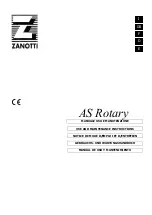
1
1
3
2
4
5
6
7
9
10
11
8
10 mm
12
Fig. 6
Legend
1
3/8" copper tube
2
Flare nut
3
Nipple (3/8")
4
bushing (1-1/4")
5
Attachment
6
Vinyl hose
7
Suction port
8
Graduated cylinder
9
Discharge port
10 Purge pump
11 tank
12 Water
2 - test oPerAtIoN
2.1 - external visual inspection
The items below must be accessible after fitting the insulation:
•
Dampers, service valves and sight glass.
•
Temperature sensors and pressure gauges should be
replaceable.
•
Bar-thermometers need to be inserted into the wells
provided on water headers and solution pipes.
•
Evaporator headers should be removable.
2.1.1 - Chiller insulation must be correctly fitted.
The following position should not be insulated.
•
The motor section of the refrigerant pump
•
The rupture disk
2.1.2 - Installation checks
•
There should not be any rust on the chiller.
•
Flange and bolted connections should not be loose.
•
There should not be any liquid leakage from the chiller.
•
Ensure that the chiller components are not damaged.
•
Ensure that no chiller components are missing.
•
Ensure that wiring and piping are not damaged.
2.2 - solution charge
Standard units are shipped fully charged with solution, inhibitor
and alcohol.
2.3 - electrical check (see Fig. 7)
The electrical specifications must comply with the control panel
nameplate data. Check the field wiring and the palladium cell
heater wiring. Refer to exhibit LF and the specification drawings.
2.3.1 - Check the motor insulation resistance
Always ensure that the motors are disconnected from the
wiring before carrying out this check. The standard value is
10 MΩ minimum. The insulation resistance of the absorbent
pump, solution pump and purge pump should be measured at
the secondary terminals of each magnetic contactor.
2.3.2 - Measuring the insulation resistance
Measure the insulation resistance of absorbent pumps, refrigerant
pump and purge pump using the following equipment:
•
500 V d.c. megger
•
Screwdriver
2.3.3 - Precautions
The insulation resistance should be 10 MΩ minimum. Be sure
to perform this measurement at the seasonal maintenance and
after pump replacement.
1.12 - Insulation
•
After the chiller has been installed, it must be insulated.
•
Before fitting the insulation, the chiller should be placed
in its permanent position.
•
To fit insulating materials, use appropriate fixtures and
fittings.
•
Insulation on piping connections, access covers and flange
sections should be easily removable.
•
The drawings show the areas to be insulated and the
recommended insulating materials and procedures. Please
refer to exhibit LG.
•
The insulating material should be fibre glass.
•
The coeffcient of thermal conductivity is ≤ 0.04 W/(mK)
Summary of Contents for Carrier 16LJ Series
Page 51: ...51 ...














































